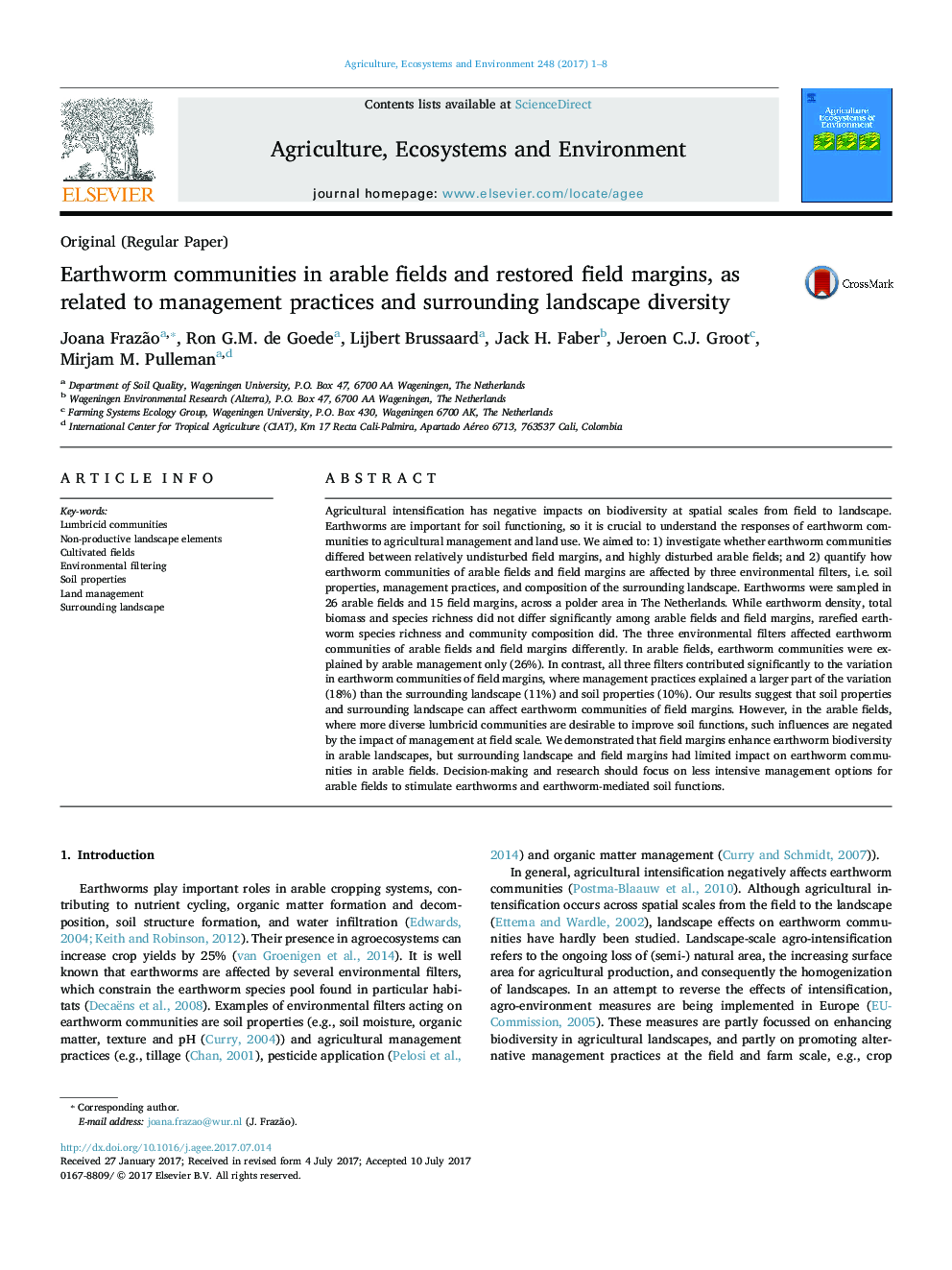| کد مقاله | کد نشریه | سال انتشار | مقاله انگلیسی | نسخه تمام متن |
|---|---|---|---|---|
| 5537798 | 1552004 | 2017 | 8 صفحه PDF | دانلود رایگان |
عنوان انگلیسی مقاله ISI
Earthworm communities in arable fields and restored field margins, as related to management practices and surrounding landscape diversity
ترجمه فارسی عنوان
جوامع کرمی کوهی در مزارع زراعی و حاشیه های زمینه های بازسازی شده، به نحوی که مربوط به شیوه های مدیریت و تنوع چشم انداز اطراف است
دانلود مقاله + سفارش ترجمه
دانلود مقاله ISI انگلیسی
رایگان برای ایرانیان
کلمات کلیدی
جوامع لومبریتی، عناصر منظره غیر تولیدی، زمینه های کشت شده، فیلتر کردن محیط زیست، خواص خاک، مدیریت زمین، چشم انداز اطراف،
ترجمه چکیده
تشدید کشاورزی تاثیر منفی بر تنوع زیستی در مقیاس های فضایی از منظر به منظره دارد. کرم خاکی برای عملکرد خاک بسیار مهم است، بنابراین برای پاسخ دادن به جوامع کرم خاکی به مدیریت کشاورزی و استفاده از زمین ضروری است. ما با هدف: 1) بررسی اینکه آیا جوامع کرم خاکی بین حاشیه های نسبتا دست نخورده تفاوت داشته اند و زمینه های بسیار زراعی را مختل می کنند؛ و 2) اندازه گیری نحوه ارتباط جوندگان کرم های خاکی از حوزه های زراعی و حاشیه های زمین توسط سه فیلتر محیطی، بویژه خواص خاک، شیوه های مدیریت و ترکیب لایه های اطراف آن. کرم های خاکی در 26 مزرعه و 15 حاشیه حوزه در سراسر منطقه لهستانی در هلند نمونه برداری شدند. در حالی که تراکم کرم خاکی، کل توده زیستی و غنای گونه در بین زمین های زراعی و حاشیه های مزرعه، غنای گونه های خاکستری خاکستری و ترکیب جامعه تفاوت معنیداری نداشت. سه فیلتر زیست محیطی، جوامع زمین کوهی و حوزه های مختلف کرم خاکی را تحت تاثیر قرار دادند. در مزارع زراعی، جوامع کرم خاکی تنها با مدیریت زراعت (26٪) توضیح داده شدند. در مقابل، هر سه فیلتر به طور قابل توجهی به تغییرات موجود در کرم های خاکی در حاشیه های مزرعه کمک می کردند، در حالیکه شیوه های مدیریت بخش بزرگی از تغییرات (18٪) را نسبت به منظره اطراف (11٪) و خواص خاک (10٪) توضیح دادند. نتایج ما نشان می دهد که خواص خاک و چشم انداز اطراف آن می توانند جوامع کرم خاکی را در حاشیه های مزرعه تحت تاثیر قرار دهند. با این حال، در زمینه های کشت زراعی، جایی که جوامع لومبیکید متنوع تر، مطلوب تر برای بهبود عملکرد خاک هستند، چنین تأثیراتی تحت تأثیر مدیریت در مقیاس حوزه نادیده گرفته می شوند. ما نشان دادیم که حاشیه های مزرعه باعث تشدید تنوع زیستی کرم های خاکی در مناظر زراعی می شود، اما حاشیه های چشم انداز و حوزه های اطراف آن تأثیر محدودی بر روی جوامع کرمی در زمین های زراعی داشته اند. تصمیم گیری و تحقیق باید بر روی گزینه های مدیریت منابع انسانی کمتری برای مزارع حاصلی برای تحریک کرم های خاکی و توابع خاک مداری از خاک خاک تمرکز کند.
موضوعات مرتبط
علوم زیستی و بیوفناوری
علوم کشاورزی و بیولوژیک
علوم زراعت و اصلاح نباتات
چکیده انگلیسی
Agricultural intensification has negative impacts on biodiversity at spatial scales from field to landscape. Earthworms are important for soil functioning, so it is crucial to understand the responses of earthworm communities to agricultural management and land use. We aimed to: 1) investigate whether earthworm communities differed between relatively undisturbed field margins, and highly disturbed arable fields; and 2) quantify how earthworm communities of arable fields and field margins are affected by three environmental filters, i.e. soil properties, management practices, and composition of the surrounding landscape. Earthworms were sampled in 26 arable fields and 15 field margins, across a polder area in The Netherlands. While earthworm density, total biomass and species richness did not differ significantly among arable fields and field margins, rarefied earthworm species richness and community composition did. The three environmental filters affected earthworm communities of arable fields and field margins differently. In arable fields, earthworm communities were explained by arable management only (26%). In contrast, all three filters contributed significantly to the variation in earthworm communities of field margins, where management practices explained a larger part of the variation (18%) than the surrounding landscape (11%) and soil properties (10%). Our results suggest that soil properties and surrounding landscape can affect earthworm communities of field margins. However, in the arable fields, where more diverse lumbricid communities are desirable to improve soil functions, such influences are negated by the impact of management at field scale. We demonstrated that field margins enhance earthworm biodiversity in arable landscapes, but surrounding landscape and field margins had limited impact on earthworm communities in arable fields. Decision-making and research should focus on less intensive management options for arable fields to stimulate earthworms and earthworm-mediated soil functions.
ناشر
Database: Elsevier - ScienceDirect (ساینس دایرکت)
Journal: Agriculture, Ecosystems & Environment - Volume 248, 1 October 2017, Pages 1-8
Journal: Agriculture, Ecosystems & Environment - Volume 248, 1 October 2017, Pages 1-8
نویسندگان
Joana Frazão, Ron G.M. de Goede, Lijbert Brussaard, Jack H. Faber, Jeroen C.J. Groot, Mirjam M. Pulleman,
